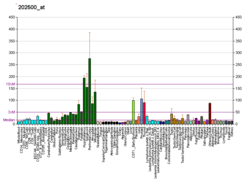DNAJB2
DnaJ homolog subfamily B member 2 is a protein that in humans is encoded by the DNAJB2 gene.[5][6][7]
References
- 1 2 3 GRCh38: Ensembl release 89: ENSG00000135924 - Ensembl, May 2017
- 1 2 3 GRCm38: Ensembl release 89: ENSMUSG00000026203 - Ensembl, May 2017
- ↑ "Human PubMed Reference:".
- ↑ "Mouse PubMed Reference:".
- ↑ Cheetham ME, Brion JP, Anderton BH (Jul 1992). "Human homologues of the bacterial heat-shock protein DnaJ are preferentially expressed in neurons". Biochem J. 284 ( Pt 2) (Pt 2): 469–76. PMC 1132662. PMID 1599432.
- ↑ Chapple JP, Hardcastle AJ, Kurzik-Dumke U, Collier DA, Cheetham ME (Oct 1999). "Assignment of the neuronal cochaperone, HSJ1, to human chromosome bands 2q32→q34 between D2S295 and D2S339 by in situ hybridization and somatic cell and radiation hybrids". Cytogenet Cell Genet. 86 (1): 62–3. doi:10.1159/000015411. PMID 10516435.
- ↑ "Entrez Gene: DNAJB2 DnaJ (Hsp40) homolog, subfamily B, member 2".
Further reading
- Bonaldo MF, Lennon G, Soares MB (1997). "Normalization and subtraction: two approaches to facilitate gene discovery". Genome Res. 6 (9): 791–806. doi:10.1101/gr.6.9.791. PMID 8889548.
- Ohtsuka K, Hata M (2001). "Mammalian HSP40/DNAJ homologs: cloning of novel cDNAs and a proposal for their classification and nomenclature". Cell Stress Chaperones. 5 (2): 98–112. doi:10.1379/1466-1268(2000)005<0098:MHDHCO>2.0.CO;2. PMC 312896. PMID 11147971.
- Wistow G, Bernstein SL, Wyatt MK (2002). "Expressed sequence tag analysis of human RPE/choroid for the NEIBank Project: over 6000 non-redundant transcripts, novel genes and splice variants". Mol. Vis. 8: 205–20. PMID 12107410.
- Strausberg RL, Feingold EA, Grouse LH (2003). "Generation and initial analysis of more than 15,000 full-length human and mouse cDNA sequences". Proc. Natl. Acad. Sci. U.S.A. 99 (26): 16899–903. doi:10.1073/pnas.242603899. PMC 139241. PMID 12477932.
- Chapple JP, Cheetham ME (2003). "The chaperone environment at the cytoplasmic face of the endoplasmic reticulum can modulate rhodopsin processing and inclusion formation". J. Biol. Chem. 278 (21): 19087–94. doi:10.1074/jbc.M212349200. PMID 12754272.
- Janket ML, Manickam P, Majumder B (2004). "Differential regulation of host cellular genes by HIV-1 viral protein R (Vpr): cDNA microarray analysis using isogenic virus". Biochem. Biophys. Res. Commun. 314 (4): 1126–32. doi:10.1016/j.bbrc.2004.01.008. PMID 14751250.
- Hillman RT, Green RE, Brenner SE (2005). "An unappreciated role for RNA surveillance". Genome Biol. 5 (2): R8. doi:10.1186/gb-2004-5-2-r8. PMC 395752. PMID 14759258.
- Colland F, Jacq X, Trouplin V (2004). "Functional Proteomics Mapping of a Human Signaling Pathway". Genome Res. 14 (7): 1324–32. doi:10.1101/gr.2334104. PMC 442148. PMID 15231748.
- Gerhard DS, Wagner L, Feingold EA (2004). "The Status, Quality, and Expansion of the NIH Full-Length cDNA Project: The Mammalian Gene Collection (MGC)". Genome Res. 14 (10B): 2121–7. doi:10.1101/gr.2596504. PMC 528928. PMID 15489334.
- Westhoff B, Chapple JP, van der Spuy J (2005). "HSJ1 is a neuronal shuttling factor for the sorting of chaperone clients to the proteasome". Curr. Biol. 15 (11): 1058–64. doi:10.1016/j.cub.2005.04.058. PMID 15936278.
- Rual JF, Venkatesan K, Hao T (2005). "Towards a proteome-scale map of the human protein-protein interaction network". Nature. 437 (7062): 1173–8. doi:10.1038/nature04209. PMID 16189514.
- Borrell-Pagès M, Canals JM, Cordelières FP (2006). "Cystamine and cysteamine increase brain levels of BDNF in Huntington disease via HSJ1b and transglutaminase". J. Clin. Invest. 116 (5): 1410–24. doi:10.1172/JCI27607. PMC 1430359. PMID 16604191.
- Adaimy L, Chouery E, Megarbane H (2007). "Mutation in WNT10A Is Associated with an Autosomal Recessive Ectodermal Dysplasia: The Odonto-onycho-dermal Dysplasia". Am. J. Hum. Genet. 81 (4): 821–8. doi:10.1086/520064. PMC 1973944. PMID 17847007.
This article is issued from
Wikipedia.
The text is licensed under Creative Commons - Attribution - Sharealike.
Additional terms may apply for the media files.




